Hawick Tree Surgeons (TD9) Scotland: Adding structure, substance and style to what can quite often be a 2 dimensional landscape, trees are an important feature of properties and gardens in Hawick. This is fine and dandy, but when trees are diseased, poorly maintained, or affected by extreme weather conditions like high winds or flooding, problems may develop that will need to be addressed. Before any work commences, the best option is to get advice from an established tree surgeon in Hawick, when your trees need attention.
There's an enormous risk of damage to property, the trees and to life, for those in Hawick who attempt to do tree work on their own, or by hiring non-qualified personnel. However, tree work isn't a safe undertaking, even for trained tree surgeons, who know about all the hazards. Within the profession there are an average of 3 deaths and 140 severe injuries per year, making tree surgery among the most dangerous jobs in the United Kingdom.

With falling trees or branches causing around 5 deaths per year in the UK, a threat to life can even be presented by a damaged or neglected tree. If you hire somebody to perform tree work and there is an injury, or damage to property, you could be liable for any compensation to any third-party. These are just a few of the reasons why hiring a professional Hawick tree surgeon to carry out the work on your trees is very important. (The figures given were sourced from HSE).
There are two principal industry bodies, one or both of which a skilled Hawick tree surgeon should be a signed up member of. You can check the professional status and membership of any tree surgeon on the websites of either the International Society of Arboriculture (ISA) or the Arboricultural Association (AA). On this webpage you can check for membership of either of these bodies, which gives the tree surgeon in question, Approved ARB Contractor status.
If there is a problem during the course of the tree work, or after it's been carried out you can contact these professional associations for arbitration assistance and for guidance and help.

You should graciously decline the offer of a quotation from anybody who you're unable to find on this directory, and continue your search for a fully qualified and approved tree surgeon. It's wise to get at least three different price quotes from various companies in and around Hawick, as soon as you have diligently checked their professional associations and accreditations. Because of the risks involved in tree work, you should ask the questions below, expressing that you need a response:
- Can you provide a quotation in writing? You should only ever accept a quote in writing. NEVER settle for a verbal quote only.
- Can I contact some past clients to check the standard of your work? It's advisable to perform an independent check of any recent work.
- Precisely what level of insurance coverage have you got? Your tree surgeon ought to be able to produce an insurance certificate covering no less than five million pounds public liability, as recommended by the AA and ISA.
- Have you got documents to indicate that you've got the recommended qualifications, membership of the AA or ISA, and also a certificate for basic chainsaw use from the NPTC/LANTRA? It is required by law that any worker/tree surgeon who uses a chainsaw must have gained NPTC/LANTRA certification. City & Guilds Diplomas and Certificates in Arboriculture are qualifications that may be held by a trained Hawick tree surgeon.
The written quotation should include clear and precise details of the work to be undertaken. It should include information on any trees which might be protected, and the steps necessary to get permission to carry out work on them, and also state who's responsible for the removal of waste, tree branches and stumps. You should also make sure VAT is included on the quote unless you're a commercial enterprise. It is extremely important that only qualified people are employed to work on your trees and property, and this is entirely down to you.
PRIOR TO WORK BEGINNING - Your preferred Hawick tree surgeon will need to enquire whether any of your trees are protected and make the necessary steps to make certain that any tree work can get the go-ahead from the local authority. Finding a tree has got protected status does not imply that work can't be carried out, since even protected trees require maintenance so as to cut back old or dying wood and ensure public safety.
No less than 6 weeks written notice is required to the Local Planning Authority prior to any work being undertaken, if your property in Hawick is situated in a conservation area. However, tree trunks of under seventy five millimetres in diameter when measured at 1.5 metres above ground level are free from this requirement. Also, if a protected tree's branches need to be thinned or pruned in order to promote and stimulate growth, written notice will not be necessary.
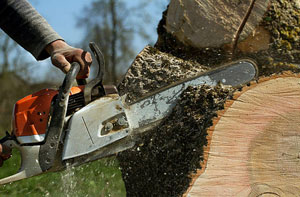
After doing a complete assessment of your trees health, your chosen Hawick tree surgeon will determine the remedial treatment required and how the required outcome can be achieved with safety in mind. Public spaces, your property and any sections of a neighbour's property that could be affected by falling debris and branches will all be given a full risk assessment. The amount of operatives required and the level of protection needed, will also be established at this stage. This is both personal protection equipment and other safety measures to keep the public and other property safe from harm or damage.
ON THE DAY OF WORK - Before any tree felling, cutting of branches or climbing commences, barriers, safety measures and cones will be put in place to keep unauthorised persons away from the area where work is going on. Where there's a possibility of debris and branches falling onto a highway, it might be necessary to temporarily stop the traffic.
The tree surgeon will need different degrees of protection according to the type of work being carried out. When carrying out basic work with a chainsaw, to avoid cutting injuries to the legs, hands and torso, they will as a bare minimum be wearing specialist protective clothing. At all times, every operative involved in the work should wear head and eye protection, and high visibility clothing.
If working at height is involved, associated safety climbing equipment and ladders will need to be used, and extra personnel will be on hand to help with the safe removal of high branches and heavy pieces of tree trunk. For the removal of waste, access to the work site will be needed. Therefore, it's advisable to inform your next door neighbours, because a skip or pick up truck will need to be parked as close to the work area as possible whilst the work progresses.
AFTER COMPLETION OF WORK - Once the work has been concluded all the waste can be taken away and the whole site cleared of any debris. Your tree surgeon will then sign off and give you a certificate of work done, especially where the trees are covered by TPOs. Pathways and roads can then be re-opened to the public, with any safety measures in public spaces being taken away.
If you've got any complaints about or issues with the work, you should get them fixed straight away by first of all taking them up with your tree surgeon. If your tree surgeon is a member of a professional body, and any further arbitration is needed, you can obtain advice and help from the AA or the ISA so as to reach an acceptable solution.
Locally based Hawick tree surgeons will most likely have the postcode TD9 and the telephone code Dialling code 01450. They'll operate in Hawick itself, as well as nearby areas such as Ashybank, Jedburgh, Ashkirk, Langholm, Broadhaugh, Oxnam, Lockerbie, Selkirk, Branxholm, Newmill, Newcastleton, Branxholm Bridgend, Moffat, Burnfoot, Harwood on Teviot, and these postcodes: TD9 7QQ, TD9 7AG, TD9 7QP, TD9 8AD, TD9 0DP, TD9 0WX, TD9 0HA, TD9 0AD, TD9 7EP, TD9 7HL. Checking this out will guarantee that you access a local tree surgeon. Hawick property owners will be able to utilise these and lots of other similar services.
If you require this type of service it is certainly a good idea to use a competent local tree surgeon. Hawick business and home owners can greatly benefit from the knowhow and skills that a seasoned professional can offer.
Pollarding Trees Hawick
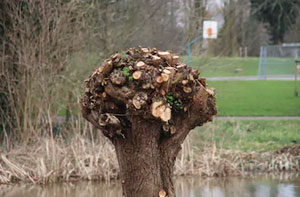
The method whereby the size of a tree is substantially lessened because it's got too large for its existing surroundings, is know as pollarding. The development of cultivated qualities and the altering of trees into certain shapes or forms can also be accomplished by the pollarding method. It can quite often be witnessed on trees that serve as boundaries or hedgerows, as well as trees that grow alongside highways in Hawick. Since pollarded trees have got such a bare and harsh visual appearance, and will likely never get back to their former shape, the course of action isn't very popular with tree lovers. The advantageous aspect of pollarding, is that trees which may otherwise have to be chopped down can be saved in-situ. Pollarding is typically done on broad-leafed tree species like limes, sycamores, planes, horse chestnuts, beeches, oaks and maples. (Tags: Tree Pollarding Hawick, Tree Pruning Hawick, Pollarding Hawick)
Safe Tree Surgery

One of the principal considerations with doing tree surgery in Hawick is the health and safety aspect, as it can definitely be a hazardous enterprise if conducted incorrectly. If the "tradespeople" engaged in the work are inexperienced or untrained, there are a number of factors that may go wrong such as little or no fall protection, in the form of platforms, ropes and harnesses, falling branches and timber, not wearing eyesight or hearing protection, a lack of head protection, failing to wear cut resistant clothing (in particular boots and trousers) and neglecting to cordon-off the area to safeguard vehicles and the public. In jeopardy owing to this sort of incompetence are passers by, the tree surgeon (up the tree), facilities on the street, the tree itself, personnel on the ground, the property owners, the property or home, garden features and fencing, stationary and passing vehicles.
Air-Spading Hawick
When you've got worries about the health of a tree, this may be down to a number of issues, but is very often because of problems with the tree's root system. So as to check for soil compaction, root rot, or other problems, a local Hawick tree surgeon may need to access the root system of your tree.
Previously this was fairly difficult, due to the possibility of damaging the roots in the process of digging down. The method that some modern day tree surgeons use is called "air spading", which is where compressed air is used to break up and clear away compacted soil without damaging tree roots or underground utilities.
The general health of a tree can be affected when the soil surrounding the roots becomes compacted by heavy foot traffic, passing vehicles or building work. When a tree is "stressed" it can become more vulnerable to attacks by pests, diseases and insects, and this stress can be caused by a lack of water and nutrients. Also great for dealing with root flare issues, air-spading can be employed to clear away the soil from the base of a tree which has become covered in soil, heightening the chance of root decay.
This clever process involves the use of an air compressor and an air-spade tool which directs air into the soil at a speed of 1200mph, the air enters the voids in the soil and immediately breaks it up, while leaving tree roots and utility lines unaffected. The flow of air blows the soil away from the tree's roots, allowing immediate inspection. A loose layer of wood chip mulch and fertiliser can then be applied to encourage the tree to revive, and a resolution implemented for any issues.
Stump Grinding
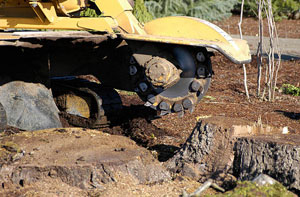
If you want to have some stump grinding done, it is sensible to hire a company having the correct machinery and knowhow. The finest Hawick tree surgeons will appreciate that every single bit of the tree stump needs to be eliminated down to a depth of at least 30 cm. Possessing the appropriate equipment means that they're able to remove stubborn stumps and roots right up to buildings and walls without without damaging them. The purpose built machinery will also be able to tackle any stumps in alleys and passageways. When you're taking out a large tree the stump left over will be fairly enormous and no matter what you're planning to use the resulting space for, the chances are that the remaining stump will have to be ground down to a good depth.
Crown Thinning Hawick
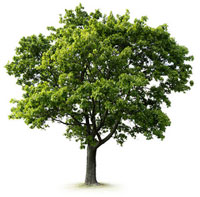
The removal of a number of the lesser branches on the tree's outer crown to create a foliage density that is consistent throughout and does not change the shape or size of a tree, is generally termed crown thinning. This specific tree work is mostly only carried out on trees with broad leaves and is to prevent the tree being uprooted when it's windy, to minimize the stress upon specific branches because of wind, ice, snow, or gravity, to lower the total weight of the crown, to allow more light to pass through or to decrease the tree's wind resistance. Crown thinning should never change the general shape and size of the tree, but should create a uniform thickness of foliage around consistently spaced branches. You'll be able to obtain crown thinning in Ashybank, Jedburgh, Ashkirk, Langholm, Broadhaugh, Oxnam, Lockerbie, Selkirk, Branxholm, Newmill, Newcastleton, Branxholm Bridgend, Moffat, Burnfoot, Harwood on Teviot, and in Hawick.
Tree Root Problems Hawick
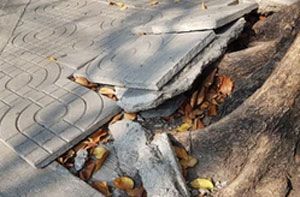
You could face issues when some larger trees which have particularly intrusive roots are growing too near to your Hawick dwelling. Problems that can develop include cracked patios, blocked drains and damaged foundations. Species like maples, elms, sycamores and willows, are trees that have very intrusive root systems.
If you're planting any new trees, make certain they are placed far enough away from pathways, your sewerage pipes, your home and patio areas, so they don't cause serious problems later on. If you already have issues with existing trees that are growing too close to your house, you can get help and advice by getting in touch with a local Hawick tree care specialist.
This is not really the sort of job you should try and do for yourself, and simply hacking away at the problematic tree roots could kill the tree or severely threaten it's overall health. Knowing which roots should be left in place, and which roots can be cut is the realm of the specialist, and an experienced Hawick tree care specialist will make sure the tree can still get ample food and water to survive successfully.
Subterranean drains are highly attractive to tree and shrub roots, because they provide a continuous source of nutrients and moisture, and they can frequently suffer cracks and structural damage. A drainage system's joints can soon be compromised by minute tree roots, which once established can grow into massive root balls and eventually cause blockages and joint failure. To get rid of the offending roots, specialised root removal solutions will be offered by many local tree surgeons, who will employ high pressure water jetting, electro-mechanical equipment or manual rod clearance.
Dutch Elm Disease
A fungal disease which has killed off tens of millons of precious elm trees all around Britain during the last 50 yrs or so, Dutch Elm Disease (Ophiostoma novo-ulmi) isn't quite as big a concern as it once was. Inadvertently introduced into Great Britain, in infected elm logs imported from North America (Canada) in the late 1960's, Dutch Elm Disease (DED) is caused by the Ophiostoma novo-ulmi fungus which is spread by the elm bark beetle (Scolytus).
After arriving in the UK, it quickly spread through the movement of elm products such as bark mulch, crates, saplings, and logs with the bark still attached. This terrible disease didn't just impact elms in the United Kingdom, but also decimated elm stocks in mainland Europe and North America. While the origins of DED are unproven, the suspicion is that it first came from Asia (probably Japan).
Dutch Elm Disease usually first shows up in early summer, and the main signs are:
- Dark streaks under the bark of twigs.
- Twigs that turn into a "shepherd's crook" shape.
- Affected shoots dying back from the tips.
- Clusters of yellow leaves that wilt and then fall.
The felling of dying, infected and dead trees, has effectively eradicated the elm bark beetle's habitat, and in recent times the spread of Dutch Elm Disease has been significantly slowed. A project for the propagation of young elm saplings that up to now have proven resistant to Dutch Elm Disease is currently being undertaken.
You can request a diagnosis from the THDAS (Tree Health Diagnostic and Advisory Service), or you can get in touch with your neighbourhood tree surgeon for guidance, if you've got elm trees in your garden in Hawick, and suspect they might be affected by DED.
Tree families affected: Ulmacae and Zelkova.
Vectors - beetles of the Scolytus family.
Cause - fungi Ophiostoma Novo-Ulmi & Ophiostoma Ulmi.
Tree Transplanting Hawick
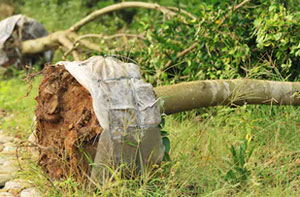
Removing mature trees and transplanting them in a new location may sound challenging, but with heavy, modern lifting equipment and truck mounted spades, it's become a comparatively straightforward endeavour. Mature trees can be replanted onto new ground to create an instantly landscaped appearance, or out-of-control woody areas could be thinned out without having to turn to tree felling.
Transplanting a tree in Hawick causes less stress to the roots and wellbeing of the tree in the autumn and winter, but it can be done during the warmer summer season by thoroughly soaking the soil before removal. Removing an adult tree involves a mechanical tree spade digging down and encircling the main root-ball, before raising the entire tree, uninjured, from the earth. The uplifted tree can then be replanted or stored temporarily before its transplanting in a new location.
Even protected trees can be moved and transplanted by a professional tree moving firm in Hawick, as long as all appropriate preservation orders and authorisations are approved by the woodland organisations and authorities. (Tags: Tree Replanting Hawick, Tree Transplanting Hawick, Tree Moving Hawick).
TPOs (Tree Preservation Orders) Hawick
Before you do any serious work on your trees in Hawick, you need to make certain that there is not a Tree Preservation Order (TPO) on any of them. You should talk to your local authority to find out if any of the trees within the boundary of your property are covered by Tree Preservation Orders. If any of your trees have Tree Preservation Orders, you are prohibited from undertaking wilful damage, lopping, removal, wilful destruction, topping, uprooting or felling, without written approval from your local authority. Any good tree surgeon in Hawick will be happy to help you through this process.
If your property is in a conservation area in Hawick, and intend to conduct any work on a tree with a stem diameter of 75 millimetres or more (1.5m from ground level), you have to give a minimum of 6 wks notice in writing to your local authority.
Tree Surveys Hawick
There are a variety of reasons why you might need to have a tree survey conducted, and the most common is for development or property extension. If, for example, you are clearing a piece of land in Hawick to make space for an extension to an existing property or a brand new home, and there are trees standing on that land, you will need to conduct a tree survey to BS5837 British Standards. Hawick tree surveys on both public and private property, must be carried out by an accredited tree surveyor or tree surgeon.
Within the defined area, a properly done tree survey will produce a whole bunch of information about the trees. For example:
- The existence of any TPOs (Tree Preservation Orders).
- The species of trees.
- The diameter of each tree (measured 1.5m above the ground).
- Allocating a unique reference number for each of the trees.
- The ages of the trees (i.e. young, semi-mature, mature, over-mature and veteran).
- The number of trees (those of over 75mm diameter 1.5m from ground level).
- The spread of the branches to North, South, West and East.
- The health of the trees.
- Recommendations for tree management.
- The expected lifespan of the trees.
- The height of each tree in metres.
If you are altering an existing home or property in Hawick but you're not extending the property's footprint and aren't changing the service lines or access points, a tree survey probably won't be required.
Protecting Trees and Shrubs in the Wintertime
Even though you might not feel that the weather conditions in the British Isles are harsh enough to justify protecting your shrubs and trees, it may be a good idea to take a second look at this. The winter season can in fact be a tough time for shrubs, trees and plants and even those that we usually think of as hardy can benefit from some added protection during times of intense cold.
When you've got trees on your property in Hawick, it's strong winds that cause the biggest concerns, and they could still be susceptible even though many of them will already have shed their leaves come winter, thus being less resistant to wind. If you are worried about the condition of a tree, or it seems like it may topple over, you must call in a local tree surgeon to examine it and conduct a risk assessment. You can also have issues with breaking branches due to heavy snowfall, so when such weather is expected, keep your eyes peeled for possible damage. Some trees and shrubs, particularly newly planted ones, might require some protection from ice and frost, and a thick covering of mulch will help keep the soil frost-free around their bases.
Dead-Wooding Hawick
All experienced tree surgeons in Hawick will undertake the practice known as dead-wooding (or deadwooding), which is an important element of tree management and care. When there is a chance of dying and dead branches falling onto vehicles, passers-by or property, dead-wooding will be carried out to remove the offending limbs. The branches of a tree can die for a number of different reasons, the most common being damage to the root system, light deficiency, disease or pest attacks.
The purpose of removing dead branches is most frequently that of safety, nevertheless, it's also sometimes done for the benefit of the tree or purely to make the tree look more attractive. An excess of dead, damaged and dying branches can attract infestation by insects and the spread of disease, therefore the removal of these impaired branches can radically improve a tree's health. You can also make a tree look more attractive through this procedure, as a tree with lots of dead wood can also look rather unappealing.
As smaller dead branches present a minimal risk, only the largest ones will be cut out in most instances. Although, where a public area, a park, a dwelling, a garden or a road in Hawick is overhung by trees, any dead limbs of more than fifty millimetres diameter might need to be removed.
Wood Chipping Hawick

So as to process the large volume of vegetation, tree limbs and branches that result from their work, most Hawick tree surgeons will make use of wood chipping machines. Quickly gobbling up as much as forty tons of material each hour, these impressive wood chipping machines can handle just about as much as you are able to feed into them. Even the smaller, more commonly used models can process a respectable 5 tonnes each hour without any issues.
Chipping down the waste material in this way makes it a lot easier to transport and also provides a useful material that is good for various purposes for instance, cultivating mushrooms, woody mulch, garden walkways, ecosystem restoration, landscaping, wood pulp, biomass solid fuel and weed prevention.
If you've a use for the wood chippings that have been generated during your tree surgery assignment, most tree surgeons in Hawick will be delighted to let you have whatever you want, and they'll cart away the rest to use on other projects, or dispose of ethically. Even when you do not require any tree surgery to be done on your property in Hawick, tree surgeons are still an excellent source for wood chips that you can use for various purposes throughout your garden. If you need wood chippings to be delivered then some tree surgeons will charge a fee for this service, others let you have them without cost.
Wood chipping machinery is made by a number of companies, some of the most widely known brands include Hyundai, Forst, Forest Master and Timberwolf.
The Use of Chainsaws
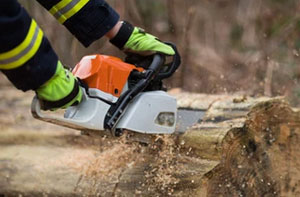
The most dangerous and probably the most common piece of equipment that's used by Hawick tree surgeons, is the chainsaw. Although mains and battery versions of chainsaw can be purchased, the most preferred by tree care professionals are driven by petrol, because of their ease of use and portability. Where thick branches and large tree stems need cutting, such heavy tree work calls for the use of the most powerful petrol driven chainsaws.
A chainsaw consists of an engine and a rotating chain with a row of teeth that cut through the bark and wood of a tree. There are also a variety of styles of chainsaw, rear-handled for working on the ground (must always be used with two hands), pole saws for long distance pruning and hard to reach branches and top-handled for working at height (and which can be used single handedly if necessary).
Whilst it isn't the safest thing to be carrying up a tree, it's very rare that you'll find an experienced Hawick tree surgeon who does not use a chainsaw virtually every day. All tree surgeons must be trained in the maintenance and safe use of chainsaws, and it is one of the main requirements for membership of the Arboricultural Association (AA).
There are several different brands and models of chainsaw, but the main ones used by tree surgery specialists in the UK are Stihl, Hyundai, Makita and Husqvarna.
Tree Cable Bracing Hawick
Cable bracing is a procedure that's used to offer support to a tree when it is showing signs of decay, damage, or poses a risk to surrounding property (or persons). Where older or valuable trees in Hawick are involved, cable bracing is used where it is undesirable to chop down a tree or cut out large sections that are unsafe or unstable.
A cable bracing set-up can be used to support defective joints, V-shaped forks and weak limbs. Carrying out different forms of bracing work, a professional tree care specialist will be equipped to use rods and cables to help alleviate structural stress, and hopefully prolong the lifespan of veteran trees in Hawick.
A non-invasive approach, that will not cause damage to the tree (as is the case when drilling and bolting the troublesome branches), cable bracing provides shock-absorbing and flexible support. Before any actual work can begin, a thorough risk risk assessment must be carried out to guarantee the safety of the tree and encircling areas.
Tree Surgery Tasks Hawick

Hawick tree surgeons can usually help you with formative pruning Hawick, the protection of trees from grazing, hedge reduction Hawick, waste removal, commercial tree surgery, hazard assessments, drop crotching in Hawick, crown thinning in Hawick, cabling, stump grinding in Hawick, expert tree care Hawick, stump treatment, dead-wooding, crown reduction Hawick, crown removal in Hawick, retrenchment pruning in Hawick, tree reshaping, tree topping, tree staking, forestry management, crown raising, root flare exposure Hawick, domestic tree surgery Hawick, root pruning, arboriculture, root removal, tree planning, tree health monitoring, tree lopping Hawick, fruit tree pruning, tree waste removal, tree replanting, woodland clearances, woodchipping, crown cleaning and other tree surgeon services in Hawick, Scotland. These are just a handful of the duties that are carried out by a tree surgeon. Hawick professionals will be happy to tell you about their full range of services.
Current Tree Surgery Projects
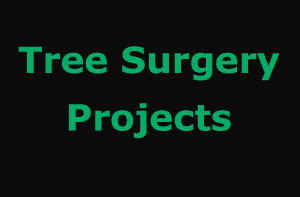
In St Andrews, Scotland Mr Winston Purvis needs a tree surgeon who can chop a tall hawthorn hedge down to a height of 6ft and remove everything afterwards. Mr and Mrs Stock are hunting for somebody to completely remove a willow tree and a conifer, and chop back a few other conifer trees in their garden in Portknockie. Ms Jasleen Harries was hoping to get a price quote from a tree surgeon in Busby who can do a bit of after winter tree and hedge pruning in the garden of her bungalow. Miss Aizah Newman in Cowie, Scotland wants someone who will chop down approximately six conifers with diameters of 150mm to 200mm. Darcy Swales was trying to track down a tree surgeon who can chop back 4 conifers and dispose of all the waste in his garden in Polbeth. In Larbert, Scotland Mr Shane Guest needs a tree surgeon to undertake the pollarding of a few trees along a path. Mr and Mrs Brooker are looking for a tree surgeon who will trim a 30 metre run of beech hedge to a sensible height in their garden in Banavie. Mr and Mrs O donnell are looking for a specialist who'll prune a maple tree that's grown over into a next door neighbours gardenin their cottage in Portree.
Getting Information and Advice
To ensure you hire a tree surgeon who is both competent and who'll not cause irreparable harm to your precious trees, there are several specific questions you need to ask when looking for a tree surgeon in Hawick. Suitable questions should be something like: Can you give me a written estimate? Do you have membership of a reputable professional association (i.e. The Arboricultural Association or the International Society of Arboriculture)? Do your working practices satisfy the British Standard (BS3998)? Do your team and you have the correct certifications and qualifications (for tree care and the use of chainsaws)? Are you able to provide references from former customers? Do you have employers and public liability insurance? If your tree surgeon does not give you positive responses to any of those questions, continue your search.

To find plenty of handy details about ways to choose a quality tree surgeon, coupled with a comprehensive directory of accredited tree surgeons in the British Isles, you should visit the AA (Arboricultural Association) site. The International Society of Arboriculture (I.S.A) is another terrific resource which boasts a "verify tree surgeon credentials" tool and a "find an arborist" tool. You might also like to check out the trusty old Wikipedia "Arborist" page here, to study lots more information on the profession of a tree surgeon. Making use of a trade review portal like My Builder or Rated People, where testimonials are available to look at and required credentials have been already confirmed, can also save you a whole lot of time and effort, because they do most of the work on your behalf. The Government backed Trustmark website is also a solid place for identifying reliable trades-people, including tree surgeons. Trustmark pays attention to excellent customer service, technical competency and good trading practices with the protection of consumers at its heart.
Tree Surgeons Near Hawick: Also find: Selkirk tree surgeon, Broadhaugh tree surgeon, Ashybank tree surgeon, Harwood on Teviot tree surgeon, Branxholm Bridgend tree surgeon, Jedburgh tree surgeon, Oxnam tree surgeon, Ashkirk tree surgeon, Moffat tree surgeon, Branxholm tree surgeon, Newmill tree surgeon, Lockerbie tree surgeon, Burnfoot tree surgeon, Newcastleton tree surgeon, Langholm here. Most of these locations are served by a certified tree surgeon. Hawick home and property owners can get price quotes by going here.
Tree Care Services Hawick
- Hawick Air-Spading
- Hawick Tree Topping
- Hawick Site Clearance
- Hawick Arboriculture
- Hawick Tree Bracing
- Hawick Tree Removal
- Hawick Eco-Plugging
- Hawick Tree Cutting
- Hawick Hedge Planting
- Hawick Hedge Reduction
- Hawick Tree Management
- Hawick Woodland Clearances
- Hawick Hedge Cutting
- Hawick Forestry Management
Tree Surgeons Around Hawick: Tree surgeons were recently carrying out work in the following Hawick areas: Old Newton, East Stewart Place, Hummelknowehaugh, Drumlanrig Place, Hallrule Mansion House, Wilton Dean, Marmion Road, Lothian Street, Cheviot Road, Commonside, Allan Water School House, Teviothead Parish Hall, Park Street, Bucklands, Clarilaw, Crailing Court, Ivanhoe Terrace, Priesthaughburn, Borthwickshiels, Ruberslaw Road, Harwood Lodge, Southdean Lodge Bothy, Stennishope, Sunnyside, Teviotdale Lodge, Mill Path, Eastlyn, Church Lane, Little Orchard, and in homes in these postcodes: TD9 7QQ, TD9 7AG, TD9 7QP, TD9 8AD, TD9 0DP, TD9 0WX, TD9 0HA, TD9 0AD, TD9 7EP, TD9 7HL. Work was conducted in these places by a qualified tree surgeon. Hawick home and property owners enjoyed the benefits of dependable and professional tree surgery services on every occasion.
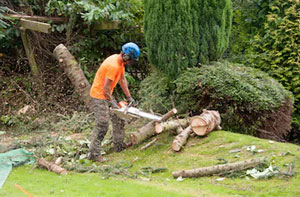 Tree Surgeon Hawick
Tree Surgeon Hawick Tree Surgeons Hawick
Tree Surgeons Hawick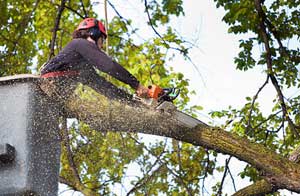 Tree Surgery Hawick
Tree Surgery HawickIf you're interested in local information about Hawick, Scotland take a look here
More Scotland Tree Surgeons: Scotland tree surgeons: Cumbernauld, Kilmarnock, Fort William, Barrhead, Alloa, Tullibody, Montrose, Motherwell, Arbroath, Forres, Buckhaven, Carluke, Livingston, Fraserburgh, Bearsden, Methil, Wishaw, Perth, Ayr, Bathgate, Tayport, Dumbarton, Newton Mearns, Stevenston, Inverness, Strathaven, Dumfries, Galashiels, Prestonpans, Erskine, Dunfermline, Lerwick, Troon, Blantyre, Galston, Greenock, Kilwinning, Coatbridge, Larbert, Hawick, Glenrothes, Stranraer, St Andrews, Irvine, Uddingston, Rosyth, Stepps, Airdrie, Prestwick, Glasgow, Renfrew, Elgin, Jedburgh, Bonnyrigg, Brechin, Inverkeithing, Ardeer, Stornoway, Armadale, Bishopton, Hamilton, Falkirk, Bonnybridge, Stenhousemuir, Bellshill, Kirkintilloch, Alva, Musselburgh, Ballingry, Inverurie, Denny, Stewarton, Whitburn, Rutherglen, Grangemouth, Kilsyth, Burntisland, Viewpark, Clydebank, Aberdeen, Linwood, Dalgety Bay, Penicuik, Westhill, Nairn, Kirriemuir, Johnstone, Dalry, Newport-on-Tay, Stonehaven, Kirkcaldy, Dingwall, Dunbar, Largs, Milngavie, Tranent, Lochgelly, Paisley, Cambuslang, Cumnock, Lanark, Peebles, Dalkeith, Ellon, Cowdenbeath, Bishopbriggs, Dundee, Forfar, Lenzie, Peterhead, Dunblane, Ardrossan, Broxburn, Linlithgow, East Kilbride, Stirling, Carnoustie, Kelso, Cupar, Edinburgh, Leven, Larkhall, Kinross and Girvan.
Tree Surgeon Jobs Hawick: Find Hawick tree surgeon jobs here: Tree Surgeon Jobs Hawick
Tree Surgery TD9 area, telephone code Dialling code 01450.
More Trades: Gate Fitters - Gutter Cleaning - Tilers - Carpet Fitters - Carpenters
Tree Reshaping Hawick - Forest Management Hawick - Tree Felling Hawick - Tree Surgeons Hawick - Crown Lifting Hawick - TD9 - Vegetation Control Hawick - Tree Management Hawick - Tree Care Hawick





